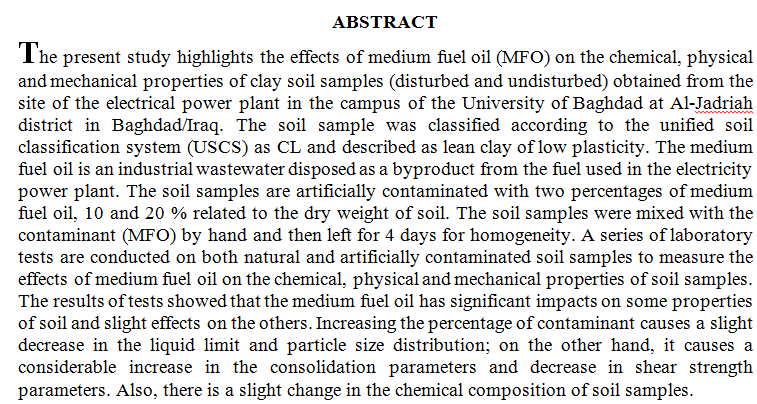
A simple and novel membraneless paper-based microfluidic fuel cell was presented in this study. The occurrence of laminar flow was employed to ensure no mixing of the fuel and oxidant fluids along the bath of reaction. The acidic wastewater was used as a fuel. It was an air-breathing cell, so air and tab water were used as oxidants. Both the fuel and tab water flowed continuously under gravity. Whatman filter paper was used for preparation of the fuel cell channel and two carbon fibre electrodes were used and firmed on the edges of the cell. The performance of the cell was examined over three consecutive days. The results indicated that the present cell has the potential to generate electric power, but an extensive study is required to harv
... Show More (4)
(4)
 (3)
(3)
The importance of specifying proper aggregate grading for achieving satisfactory performance in pavement applications has long been recognized. To improve the specifications for superior performance, there is a need to understand how differences in aggregate gradations within the acceptable limits may affect unbound aggregate base behavior. The effects of gradation on strength, modulus, and deformation characteristics of high-quality crushed rock base materials are described here. Two crushed rock types commonly used in constructing heavy-duty granular base layers in the State of Victoria, Australia, with three different gradations each were used in this study. The gradations used represent the lower, medium, and upper gradation li
... Show More (4)
(4)
 (3)
(3)
New nanotechnology-based approaches are increasingly being investigated for enhanced oil recovery (EOR), with a particular focus on heavy oil reservoirs. Typically, the addition of a polymer to an injection fluid advances the sweep efficiency and mobility ratio of the fluid and leads to a higher crude oil recovery rate. However, harsh reservoir conditions, including high formation salinity and temperature, can limit the performance of such polymer fluids. Recently, nanofluids, that is, dispersions of nanoparticles (NPs) in a base fluid, have been recommended as EOR fluids; however, such nanofluids are unstable, even under ambient conditions. In this work, a combination of ZrO2 NPs and the polyacrylamide (PAM) polymer (ZrO2 NPs–PAM) was us
... Show More (79)
(79)
 (78)
(78)
 (11)
(11)
 (3)
(3)
Exploring the antibacterial potential of neem oil (Azadirachta indica) in combination with gentamicin (GEN) against pathogenic molds, especially Pseudomonas aeruginosa, has drawn concern due to the quest for natural treatment options against incurable diseases. Prospective research directions include looking for natural cures for many of the currently incurable diseases available now. microbial identification system, were used to identify the isolates. The research utilized a range of methods, such as the diffusion agar well (AWD) assays, TEM (transmission electron microscopy) analysis, minimum inhibitory concentration (MIC) assays, and real-time PCR (RT-qPCR) to analyze bacterial expression and the antibacterial action of neem oil (Azadira
... Show More (7)
(7)
 (8)
(8)
A field experiment is conducted to study the effect of different levels of peat (0, 25, 50, 75, and 100 Mg ha-1 to uncropped and cropped soil to wheat. Soil samples are taken in different period of time (0, 3, 30, 60, 90, 120, and 180 days after cultivation to determine (NaHCO3-Exteractable P at 3 different depths (0-10, 10-20, and 20-30 cm). Field Experiment is conducted in a randomized complete block design (RCBD) with four replicates. Wheat, Al-Rasheed variety, is cultivated as a testing crop. The entire field is equally dived in two divisions. One of the two divisions is cultivated to wheat and the second is left uncropped. The effect of five levels of peat namely 0, 25, 50, 75, 100 Mg ha-1 is investigated. Soils are fully analyzed
... Show More (2)
(2)
Perennial biofuel and cover crops systems are important for enhancing soil health and can provide numerous soil, agricultural, and environmental benefits. The study objective was to investigate the effects of cover crops and biofuel crops on soil hydraulic properties relative to traditional management for claypan soils. The study site included selected management practices: cover crop (CC) and no cover crop (NC) with corn/soybean rotation, switchgrass (SW), and miscanthus (MI). The CC mixture consisted of cereal rye, hairy vetch, and Austrian winter pea. The research site was located at Bradford Research Center in Missouri, USA, and was implemented on a Mexico silt loam. Intact soil cores (76‐mm diam. by 76‐mm long) were taken from the
... Show More (4)
(4)
 (4)
(4)
 (2)
(2)
